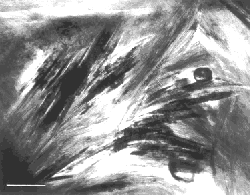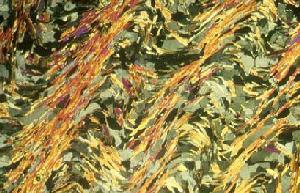An Introduction to Structural Geology and Tectonics
|
An Introduction to Structural Geology and Tectonics |
9. Ductile Deformation Processes and Microstructures
 Why
is it that a layer of rock can be permanently bent into a fold, or that
a material such as ice can be permanently contorted (or flow) over a period
of time while it remains a solid? Ice is perhaps a particularly instructive
example of flow in crystalline solids because it moves on human time scales.
At first you might think that this is accomplished by bending and stretching
of atomic bonds in the crystal lattice, but bending and stretching is elastic
deformation, and, as described in Chapter
5, elastic deformation is recoverable (i.e., non-permanent). The movement
of glaciers, however, is a permanent feature and they only retreat by melting.
Such permanent bends and contortions represent ductile deformation and
it is not recoverable. If we would be able to remove a folded layer from
an outcrop or a deformed mineral from a hand specimen they would not jump
back to their original forms. So the distortions that have occurred must
also be a result of permanent changes in the material. Understanding some
of the principles that underlie this ability of rocks to accumulate permanent
strain is contained in a vast and ever growing body of materials science
literature.
Why
is it that a layer of rock can be permanently bent into a fold, or that
a material such as ice can be permanently contorted (or flow) over a period
of time while it remains a solid? Ice is perhaps a particularly instructive
example of flow in crystalline solids because it moves on human time scales.
At first you might think that this is accomplished by bending and stretching
of atomic bonds in the crystal lattice, but bending and stretching is elastic
deformation, and, as described in Chapter
5, elastic deformation is recoverable (i.e., non-permanent). The movement
of glaciers, however, is a permanent feature and they only retreat by melting.
Such permanent bends and contortions represent ductile deformation and
it is not recoverable. If we would be able to remove a folded layer from
an outcrop or a deformed mineral from a hand specimen they would not jump
back to their original forms. So the distortions that have occurred must
also be a result of permanent changes in the material. Understanding some
of the principles that underlie this ability of rocks to accumulate permanent
strain is contained in a vast and ever growing body of materials science
literature.
 Structural
geologists have applied many of the concepts from materials science to
geologic conditions; use of the associated terminology, however, is not
always consistent between these fields. In trying to keep the terms and
concepts to a minimal, we invariably have to make some choices in this
chapter; otherwise we will loose site of our ultimate goal: understanding
the way rocks deform in the ductile regime. In Chapter
5 we first introduced the concept of flow. At that point we described
this topic merely in terms of stress and strain rate. We contrasted linear
viscous (Newtonian) and non-linear viscous (non-Newtonian) behavior using
analogs and simple mechanical models. In this chapter we will examine the
physical processes that underlie this ability of materials to undergo appreciable,
permanent distortions that are distributed through a volume of rock. Just
to refresh your memory, strain that is distributed over the body is what
distinguishes ductile behavior from brittle behavior. But strain that appears
homogeneous on one scale may represent heterogeneity on another, so we
again have to include the scale of our observation. The scales of observation
in structural geology range from nanometers (10^-9 m; Figure) to kilometers,
and single minerals to mountain ranges. For practical reasons we therefore
define ductile behavior as uniform flow down to the scale of the hand specimen.
We distinguish three fundamental mechanisms that produce ductile behavior
in rocks and minerals: (1) cataclastic flow, (2) diffusional mass transfer
and (3) crystal plasticity. Which of these processes actually occurs at
a given time in a rock is primarily a function of temperature, stress,
grain size, rock composition and fluid presence. At the onset we mention
that temperature is a particularly important parameter, but different minerals
behave ductily at different temperatures. What is considered high temperature
behavior for one mineral may be low temperature behavior for another mineral.
Thus, when talking about the relationship between temperature and deformation,
we need to use a normalized parameter that is called the homologous temperature,
Tm. The homologous temperature is a dimensionless parameter that is defined
as the absolute temperature divided by the absolute melting temperature
of the material: Th = T/Tm, with T for temperature and Tm for the
melting temperature of the material, both in K. Now, we will looely define
'low temperature conditions' as 0>Th>0.3, 'medium temperature conditions'
as 0.3>Th>0.7, and 'high temperature conditions' as 0.7>Th>1. After discussing
the fundamental mechanisms and the associated microstructures (i.e., mineral
geometries on the microscopic scale), we will close this chapter by examining
the interrelationship between the various rheologic parameters (such as
stress and strain rate; see Chapter
5), and we introduce the powerful concept of deformation mechanism
maps. Now let us first turn to the three mechanisms of ductile behavior.
Structural
geologists have applied many of the concepts from materials science to
geologic conditions; use of the associated terminology, however, is not
always consistent between these fields. In trying to keep the terms and
concepts to a minimal, we invariably have to make some choices in this
chapter; otherwise we will loose site of our ultimate goal: understanding
the way rocks deform in the ductile regime. In Chapter
5 we first introduced the concept of flow. At that point we described
this topic merely in terms of stress and strain rate. We contrasted linear
viscous (Newtonian) and non-linear viscous (non-Newtonian) behavior using
analogs and simple mechanical models. In this chapter we will examine the
physical processes that underlie this ability of materials to undergo appreciable,
permanent distortions that are distributed through a volume of rock. Just
to refresh your memory, strain that is distributed over the body is what
distinguishes ductile behavior from brittle behavior. But strain that appears
homogeneous on one scale may represent heterogeneity on another, so we
again have to include the scale of our observation. The scales of observation
in structural geology range from nanometers (10^-9 m; Figure) to kilometers,
and single minerals to mountain ranges. For practical reasons we therefore
define ductile behavior as uniform flow down to the scale of the hand specimen.
We distinguish three fundamental mechanisms that produce ductile behavior
in rocks and minerals: (1) cataclastic flow, (2) diffusional mass transfer
and (3) crystal plasticity. Which of these processes actually occurs at
a given time in a rock is primarily a function of temperature, stress,
grain size, rock composition and fluid presence. At the onset we mention
that temperature is a particularly important parameter, but different minerals
behave ductily at different temperatures. What is considered high temperature
behavior for one mineral may be low temperature behavior for another mineral.
Thus, when talking about the relationship between temperature and deformation,
we need to use a normalized parameter that is called the homologous temperature,
Tm. The homologous temperature is a dimensionless parameter that is defined
as the absolute temperature divided by the absolute melting temperature
of the material: Th = T/Tm, with T for temperature and Tm for the
melting temperature of the material, both in K. Now, we will looely define
'low temperature conditions' as 0>Th>0.3, 'medium temperature conditions'
as 0.3>Th>0.7, and 'high temperature conditions' as 0.7>Th>1. After discussing
the fundamental mechanisms and the associated microstructures (i.e., mineral
geometries on the microscopic scale), we will close this chapter by examining
the interrelationship between the various rheologic parameters (such as
stress and strain rate; see Chapter
5), and we introduce the powerful concept of deformation mechanism
maps. Now let us first turn to the three mechanisms of ductile behavior.
Links
Table
of Deformation Mechanism by Jessell and Bons (Monash Univ.)